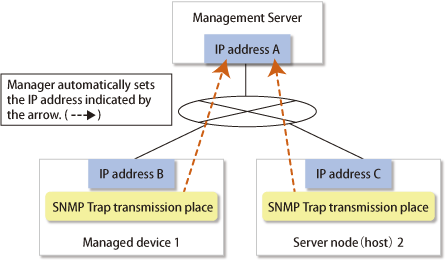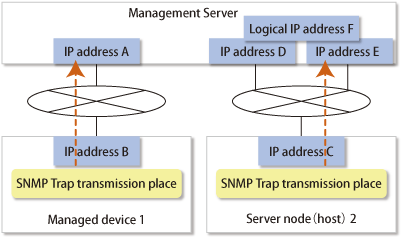The SNMP Trap transmission place automatic setting function, which is executed at the time of a device registration, and its accuracy are explained with the figures below.
This software automatically identifies IP address A of the Management Server and sets "IP address A" as the SNMP Trap transmission place for each managed device.

Such Management Server has a cluster or redundant LAN configuration or is connected to multiple subnets, and it has two or more IP addresses.
From the multiple IP addresses of the Management Server, this software selects the one that is most suitable as the transmission IP address for each device. However, this logic does not work in all cases. In the environment shown in the figure below, for example, this software may set "IP address D" as the SNMP Trap transmission place for Managed device 1. This is because addresses cannot be automatically detected in some cases due to the nature of current LAN technology. In such an environment, therefore, it is necessary to check the SNMP Trap transmission place setting of each device after the device registration process and, if required, set SNMP Trap transmission places directly on the device side.
In the figure below, specify "IP address A" as the SNMP Trap transmission place for Managed device 1, and "Logical IP address F" as the SNMP Trap transmission place for Server node 2. Refer to "2.1 Receiving SNMP Traps" for information about how to set SNMP Trap transmission place addresses of server nodes manually.

Point
In order for the server node to send the SNMP Trap, agent must be installed on the host.
Note
This function is not available for storage devices and switches registered using SNMPv3. Perform the SNMP Trap transmission setting manually for the storage device or switch using SNMPv3.